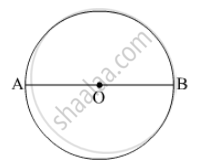Advertisements
Advertisements
प्रश्न
f the coordinates of one end of a diameter of a circle are (2, 3) and the coordinates of its centre are (−2, 5), then the coordinates of the other end of the diameter are
विकल्प
(−6, 7)
(6, −7)
(6, 7)
(−6,−7)
उत्तर

Let O(−2, 5) be the centre of the given circle and A(2, 3) and B(x, y) be the end points of a diameter of the circle.
Then, O is the mid-point of AB.
Using mid-point formula, we have
Hence, the correct answer is option A.
APPEARS IN
संबंधित प्रश्न
If two opposite vertices of a square are (5, 4) and (1, −6), find the coordinates of its remaining two vertices.
Name the quadrilateral formed, if any, by the following points, and given reasons for your answers:
A(4, 5) B(7, 6), C (4, 3), D(1, 2)
Find the points of trisection of the line segment joining the points:
5, −6 and (−7, 5),
The points (3, -4) and (-6, 2) are the extremities of a diagonal of a parallelogram. If the third vertex is (-1, -3). Find the coordinates of the fourth vertex.
If three consecutive vertices of a parallelogram are (1, -2), (3, 6) and (5, 10), find its fourth vertex.
Find the coordinates of the midpoints of the line segment joining
A(3,0) and B(-5, 4)
Find the ratio in which the point P(m, 6) divides the join of A(-4, 3) and B(2, 8) Also, find the value of m.
The distance of the point P (4, 3) from the origin is
Find the ratio in which the line segment joining the points A(3, −3) and B(−2, 7) is divided by the x-axis. Also, find the coordinates of the point of division.
If A(−3, 5), B(−2, −7), C(1, −8) and D(6, 3) are the vertices of a quadrilateral ABCD, find its area.
Find the value of k, if the points A (8, 1) B(3, −4) and C(2, k) are collinear.
If the points A(−1, −4), B(b, c) and C(5, −1) are collinear and 2b + c = 4, find the values of b and c.
If the points A(−2, 1), B(a, b) and C(4, −1) ae collinear and a − b = 1, find the values of aand b.
If the points A (1,2) , O (0,0) and C (a,b) are collinear , then find a : b.
The point R divides the line segment AB, where A(−4, 0) and B(0, 6) such that AR=34AB.">AR = `3/4`AB. Find the coordinates of R.
Abscissa of all the points on the x-axis is ______.
Ordinate of all points on the x-axis is ______.
The point at which the two coordinate axes meet is called the ______.
The coordinates of a point whose ordinate is `-1/2` and abscissa is 1 are `-1/2, 1`.
Statement A (Assertion): If the coordinates of the mid-points of the sides AB and AC of ∆ABC are D(3, 5) and E(–3, –3) respectively, then BC = 20 units.
Statement R (Reason): The line joining the mid-points of two sides of a triangle is parallel to the third side and equal to half of it.
